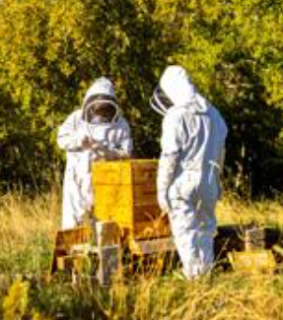"Harvesting the Sweet Rewards: A Bountiful Year for Local Beekeepers"
Introduction: As fall sets in, ranching country comes alive with the bustling activity of moving livestock and shipping calves. Meanwhile, local beekeepers are reaping the rewards of a summer's hard work, thanks to an abundance of sweet clover and diligent bees. In this article, we explore the world of beekeeping and the intricate process of harvesting honey.
A Sweet Year for Bees: The year 2023 has proven to be exceptional for beekeepers in the region. The sweet clover, known to be a favorite for bees, flourished thanks to ample rain. Justin Robinson, a hobbyist beekeeper from Kaycee, expressed his delight, stating, "This year was a great year with the sweet clover so thick. Everybody's bees did good this year."
The Enthralling World of Bees: For Justin Robinson and his wife, Cyndi, the journey into beekeeping began with curiosity. Cyndi's initial interest in keeping bees quickly turned into fascination once they established their first hive. "I was just enthralled," Justin recalls.
The Bee's Work Ethic: The phrase "busy as a bee" couldn't be more accurate. Kassahn Mathson, another hobbyist beekeeper, shared her experiences, likening every hive inspection to Christmas. The industrious nature of bees left her in awe, especially given the incredible work they accomplish in a short time.
Pollinators and Their Importance: Kassahn Mathson had contemplated beekeeping for several years, primarily due to the shortage of bees around her home, impacting the pollination of her garden plants. "We just didn't have enough pollinators," she explained. Resorting to pollinating her squash with a Q-tip emphasized the critical role bees play in our ecosystems.
The Secret Lives of Worker Bees: Robinson provided insights into the world of worker bees. These tireless female bees, comprising about 98% of the colony, visit up to 100 flowers during each foraging trip. They return to the hive only when their legs' special sacks are filled with pollen and their second stomachs brim with nectar. The organization within a hive is fascinating, as each bee has a specific role.
The Honey-Making Process: Returning to the hive, worker bees deposit both pollen and nectar. The transformation of sugar into honey is a complex process. An enzyme in the bee's stomach turns the sugar into diluted honey, which worker bees fan with their wings to remove excess water, creating honey.
The Harvesting Process: Beekeeping is both rewarding and challenging. Harvesting honey, especially for small hobbyists without specialized equipment, is no small task. Honey is stored in the second box of the hive, intended for the bees during the winter. The honey supers, where beekeepers harvest their honey, are stacked on top.
Robinson shared his preference for harvesting during the middle of the day when most bees are out foraging. While his honeybees are not known for aggression, all bees become protective of their honey during this time of year.
Harvesting Techniques: Once it's time to harvest, the beekeeper removes honey-filled frames, cuts the wax cap off the honeycomb, and places the frame in an extractor. Kassahn Mathson's family uses a hand-crank extractor, which efficiently spins the honey into a vat, collecting it for filtering.
The Reward of Harvest: The honey is filtered twice to ensure quality. Contrary to expectations, beekeepers find the process less messy and more rewarding than anticipated. The satisfaction of harvesting delicious, homegrown honey is immeasurable.
In conclusion, the 2023 honey harvest has brought joy to local beekeepers, showcasing the remarkable work of these tiny, yet incredibly diligent, insects.
#Beekeeping, #HoneyHarvest, #Pollinators, #Sustainability, #LocalHoney

